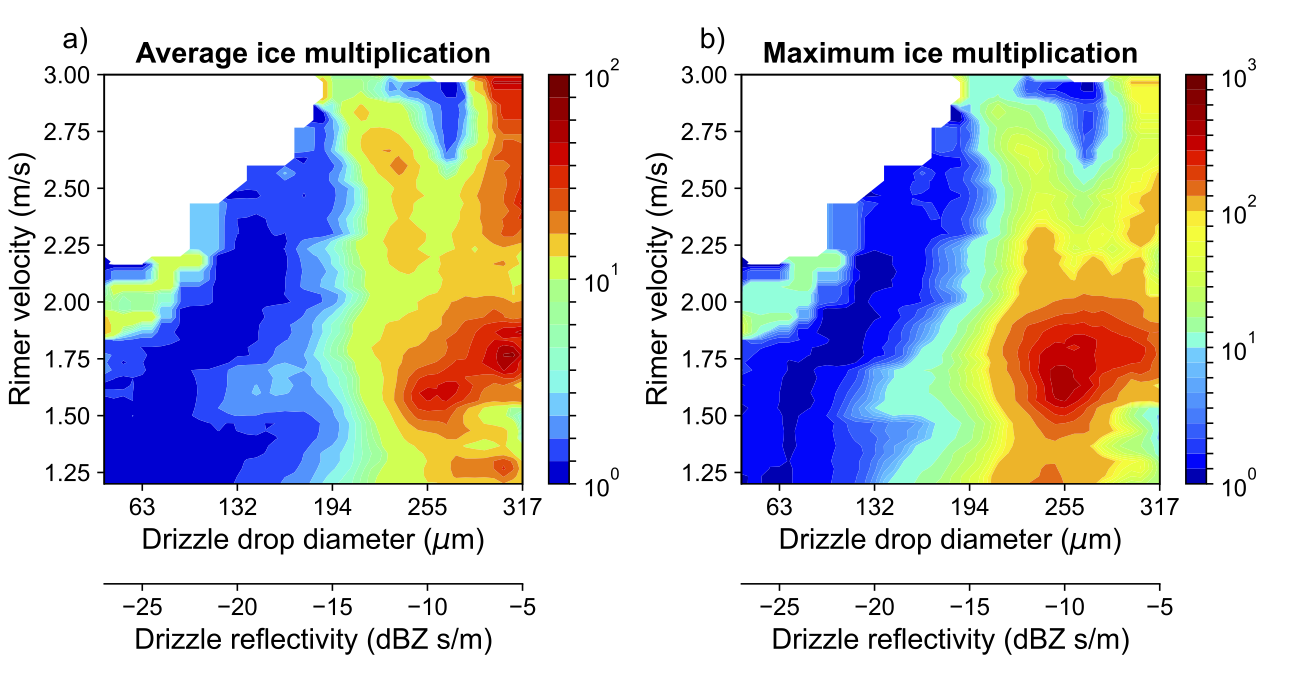New insights into ice multiplication using remote-sensing observations in the Arctic
Submitter
Luke, Edward — Brookhaven National Laboratory
Yang, Fan — Brookhaven National Laboratory
Area of Research
Cloud Processes
Journal Reference
Luke E, F Yang, P Kollias, A Vogelmann, and M Maahn. 2021. "New insights into ice multiplication using remote-sensing observations of slightly supercooled mixed-phase clouds in the Arctic." Proceedings of the National Academy of Sciences, 118(13), 10.1073/pnas.2021387118.
Science

Figure 1. Ice multiplication given as a joint function of rimer velocity and drizzle drop diameter. The color bars in a) and b) represent, respectively, the average and maximum ice multiplication numbers over the 6-year Utqiaġvik data set, which are both unitless quantities. The drizzle drop diameter is associated with drizzle spectral reflectivity (second x axis). Note the different scales for the color bars. The results indicate a greater dependence of ice multiplication on drizzle drop diameter via freezing fragmentation than on the rimer velocity associated with the better-known rime-splintering or Hallett-Mossop process. From journal.
“Secondary ice” refers to ice particles that were generated from other ice particles, rather than from primary nucleation. Secondary ice events in the natural environment may have profound implications for the evolution of mixed-phase clouds and precipitation, but for various reasons, characterization of such events has challenged the community for decades. For the first time, long-term occurrences of secondary ice events and their multiplication factors are quantified. This was achieved by applying a novel remote-sensing technique to six years of ground-based remote-sensing measurements.
Impact
Our results shed new light on two fundamental aspects of mixed-phase clouds: 1) the conditions under which secondary ice production occurs, and 2) the extent to which ice number concentration is enhanced during secondary ice events. Secondary ice events are found to occur preferentially in the presence of drizzle droplets, in contrast to the better-known rime-splintering process, causing up to a 1,000-fold enhancement in ice number concentration. These results provide critical insights for model parameterizations and future laboratory experiments.
Summary
Laboratory experiments have demonstrated the occurrence of secondary ice production (SIP) under controlled conditions (e.g., rotating rod or a levitated droplet in a calm environment), but the idealized mechanisms inferred from these experiments are not directly translatable to real-world clouds. Aircraft measurements have reported the occurrence of SIP; however, the scientific conclusions drawn from studies using such measurements suffer from the limited number of samples and temporal coverage. Here we have used the rich information content of multiyear dual-polarization radar Doppler spectra observations made at the ARM North Slope of Alaska Utqiaġvik site to obtain a robust statistical understanding of SIP. Our analyses show that, in the presence of rimer only, fairly low ice multiplication (SIP) results regardless of rimer speed within slightly supercooled clouds (with temperatures warmer than -10 ℃), suggesting limited efficacy of the well-known rime-splintering or Hallett-Mossop process. However, our results show strong dependence of SIP on increasingly large drizzle droplets, suggesting the lesser-studied freezing fragmentation process to be very efficient in these clouds. Cases with the presence of both fast rimer particles and drizzle drops had slightly greater SIP over those with drizzle alone. Our results suggest that the ice number concentration can be enhanced by up to 1,000 times during SIP events for certain combinations of rimer speeds and drizzle drop sizes. Although SIP was only observed to occur less than 10% of the time during thesix6-year period, it can have a significant impact on ice number concentration within a local region once it does occur.
Keep up with the Atmospheric Observer
Updates on ARM news, events, and opportunities delivered to your inbox
ARM User Profile
ARM welcomes users from all institutions and nations. A free ARM user account is needed to access ARM data.


















